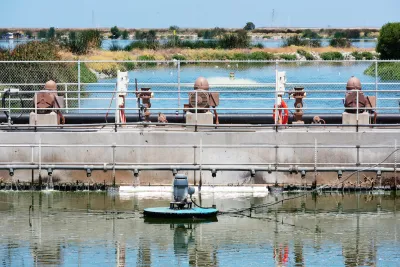The complex set of regulations will ensure recycled water makes it to taps safely.

California regulators approved the first standards for transforming sewage into potable water, reports Rachel Becker in CALmatters, paving the way for recycling and treating wastewater.
“The new rules — which have been more than a decade in the making and were mandated by a state law — outline a slew of requirements aimed at ensuring that germs and chemicals are scrubbed from treated sewage,” Becker explains.
The sewage will be bubbled with ozone, chewed by bacteria, filtered through activated carbon, pushed at high pressures through reverse osmosis membranes multiple times, cleansed with an oxidizer like hydrogen peroxide and beamed with high-intensity UV light. Valuable minerals, such as calcium, that were filtered out will be restored. And then, finally, the wastewater will be subjected to the regular treatment that all drinking water currently undergoes.
Colorado and Texas already have rules governing ‘toilet-to-tap,’ and Florida and Arizona are developing their own policies. After a final review, the California rules could be implemented sometime next year. A Southern California recycled water plant is under construction and could produce roughly 115 million gallons of water per day by 2032.
The recycled water will likely cost more than imported water, but will help secure California’s water future as water supplies in the West become more strained.
FULL STORY: California approves rules that turn sewage into drinking water

National Parks Layoffs Will Cause Communities to Lose Billions
Thousands of essential park workers were laid off this week, just before the busy spring break season.

Retro-silient?: America’s First “Eco-burb,” The Woodlands Turns 50
A master-planned community north of Houston offers lessons on green infrastructure and resilient design, but falls short of its founder’s lofty affordability and walkability goals.

Delivering for America Plan Will Downgrade Mail Service in at Least 49.5 Percent of Zip Codes
Republican and Democrat lawmakers criticize the plan for its disproportionate negative impact on rural communities.

Test News Post 1
This is a summary

Test News Headline 46
Test for the image on the front page.

Balancing Bombs and Butterflies: How the National Guard Protects a Rare Species
The National Guard at Fort Indiantown Gap uses GIS technology and land management strategies to balance military training with conservation efforts, ensuring the survival of the rare eastern regal fritillary butterfly.
Urban Design for Planners 1: Software Tools
This six-course series explores essential urban design concepts using open source software and equips planners with the tools they need to participate fully in the urban design process.
Planning for Universal Design
Learn the tools for implementing Universal Design in planning regulations.
EMC Planning Group, Inc.
Planetizen
Planetizen
Mpact (formerly Rail~Volution)
Great Falls Development Authority, Inc.
HUDs Office of Policy Development and Research
NYU Wagner Graduate School of Public Service




























